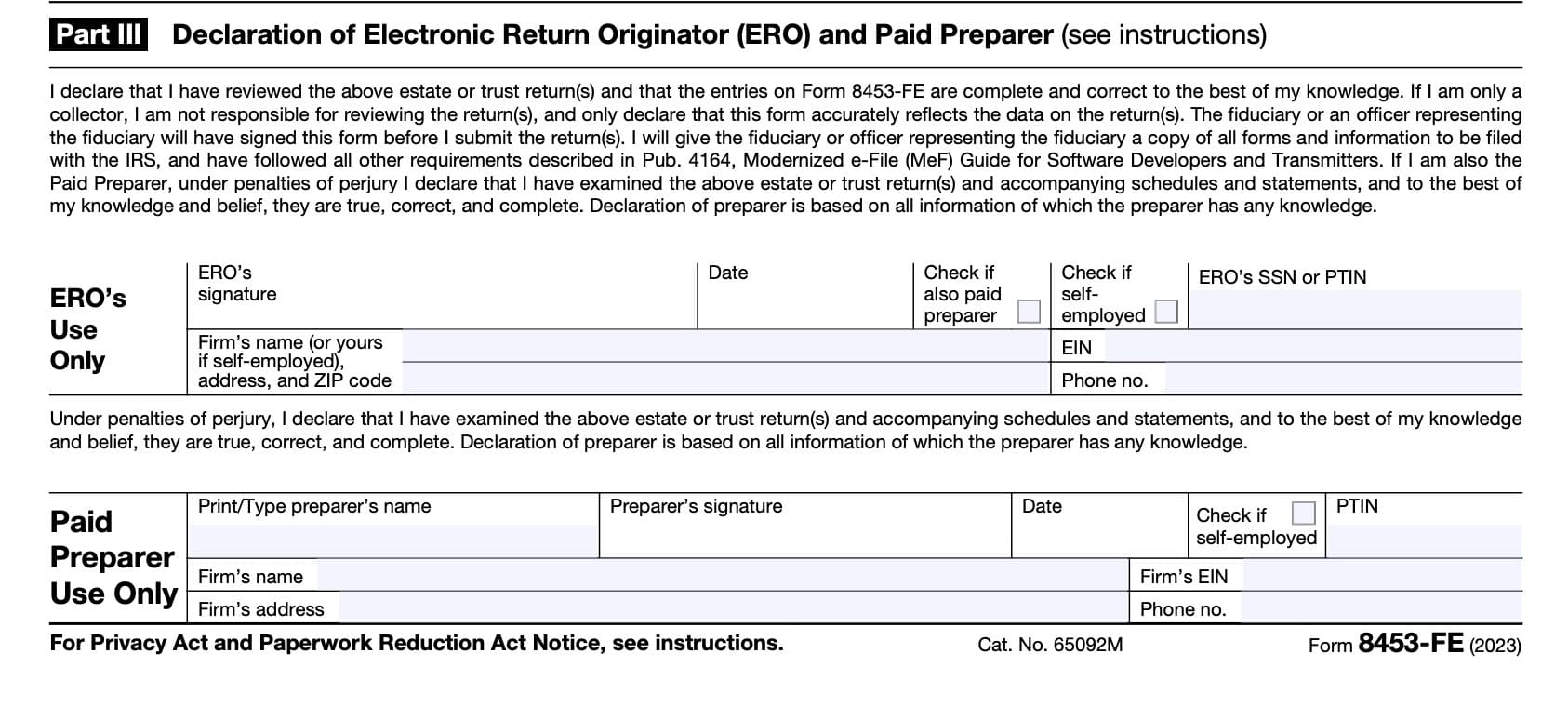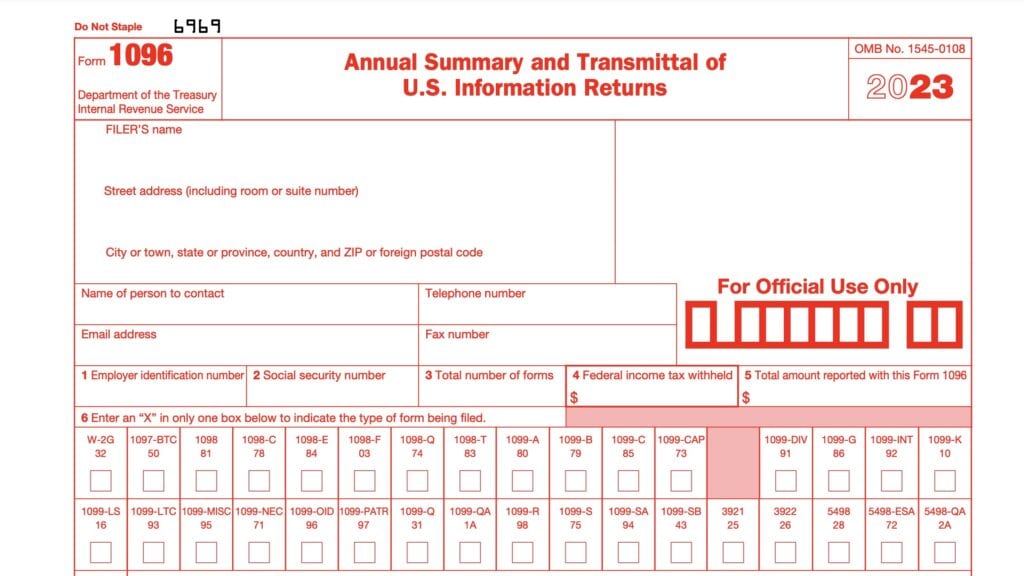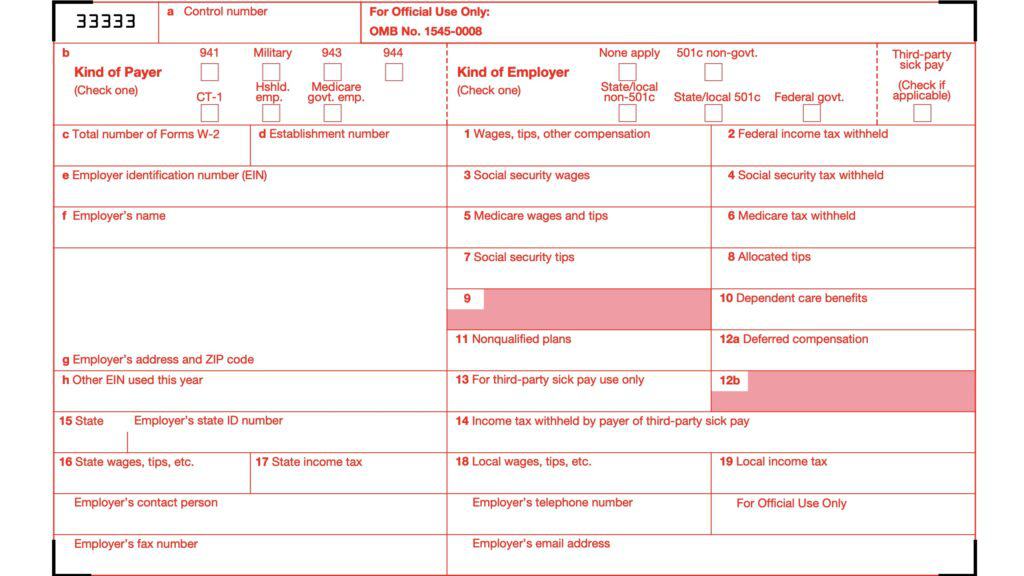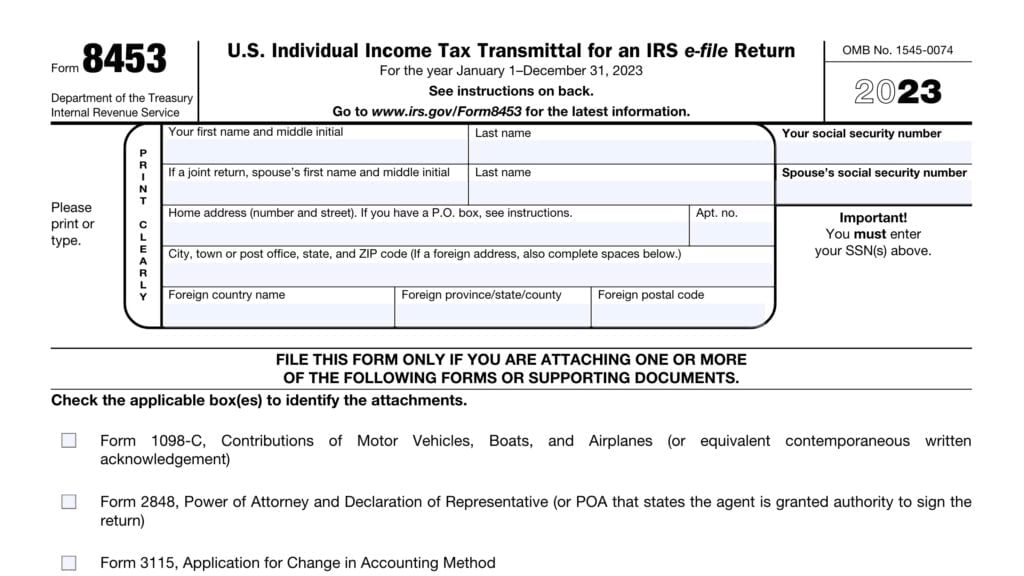IRS Form 8453-FE Instructions
If you’re the beneficiary of an estate or trust, you might see IRS Form 8453-FE as part of the tax return paperwork. And if you’re the fiduciary of an estate or trust, you’ll definitely use Form 8453-FE to authorize the electronic filing of the tax return.
This article will walk you through what you should know about this tax form, including:
- What is IRS Form 8453-FE
- How to complete this form and when you should file it
- How to obtain a copy of this tax form
Let’s start with discussing exactly what IRS Form 8453-FE is.
Table of contents
How do I complete IRS Form 8453-FE?
There are three parts to this tax form, which we’ll go through, step by step:
- Part I: Tax Return Information
- Part II: Declaration of Fiduciary
- Part III: Declaration of Electronic Return Originator (ERO) and Paid Preparer
However, let’s start at the very top of the form, in the taxpayer information fields above Part I.
Taxpayer information
In this section, you’ll enter basic information about the tax return.
Calendar year or fiscal year
If the trust or estate operates on a calendar year basis, leave this area blank.
If the trust or estate operates on a fiscal year basis, enter the beginning and ending months of the fiscal year.
Fiscal year
A fiscal year is any tax year consisting of 12 consecutive months that end on the final day of any month except December. For example, the federal government operates on a fiscal year that runs from October 1 to September 30 of the following year.
Name of estate or trust
Enter the name of the tax entity in this field.
Employer identification number
Enter the employer identification number (EIN) of the estate or trust in this field. An employer identification number is a 9-digit tax identification number for tax entities who are not individuals.

Name and title of fiduciary
Enter the fiduciary’s name and title in this space.
Part I: Tax Return Information
In Part I, fill in the corresponding lines from the estate or trust tax return in the current tax return.
Line 1: Total income
Fill in the number from Line 9 on IRS Form 1041, Total Income.
Line 2: Income distribution deduction
Enter the amount from Line 18 on IRS Form 1041. Also on Schedule B, Line 5 and substantiated on Schedules K-1.
Line 3: Taxable income
Fill in the number from Line 23 on the Form 1041, taxable income.

Line 4: Total tax
Fill in the number from Line 24 on the Form 1041. Also on Schedule G, Part I, Line 9.
Line 5: Tax due or overpayment
Fill in the number from Line 28 or 29 on the Form 1041.
If the trust or estate owes additional tax, this will be Line 28. If the federal government owes a tax refund instead, this will be Line 29.
Making tax payments
You can make payment on the taxes calculated in Line 5 by any of the following methods:
- Electronic Federal Tax Payment Sysem (EFTPS)
- Direct debit (known as ACH electronic funds withdrawal)
- Check
- Money order
If paying by debit, see the instructions for Line 6, below.
Paying by check or money order
To pay by check or money order, do the following:
- Make the check or money order out to: “United States Treasury”
- Write the following on the payment instrument:
- Estate or trust’s name
- Employer identification number
- IRS Form 1041 (form number)
- Taxable year
- Complete IRS Form 1041-V, Payment Voucher
- Enclose the voucher and payment in an envelope
- Mail the payment to the address shown on your payment voucher
Although you do not have to complete IRS Form 1041-V, doing so allows the IRS to process the payment more accurately and efficiently. Do not enclose IRS Form 8453-FE with Form 1041-V.
Part II: Declaration of Fiduciary
In Part II, the fiduciary responsible for the estate or trust will sign, under penalty of perjury, that:
- The amounts listed above match the amounts shown on the associated tax return.
- The submitted information is true, correct, and complete, to the best of their knowledge

Additionally, this section contains the authorization for the U.S. Treasury to withdraw funds from the estate or trust bank account to pay any outstanding tax liability.
Line 6
If paying by direct debit, check this box to authorize electronic funds withdrawal from your financial institution.
Part III: Declaration of Electronic Return Originator (ERO) and Paid Preparer
In Part III, the ERO and paid tax return preparer declare that the submitted information is complete and correct, under penalty of perjury.
Difference between the ERO and paid preparer
There is a difference between an electronic return originator (ERO) and a paid preparer.
Paid preparer
A paid tax return preparer is anyone who is paid to prepare the estate’s or trust’s tax return. A paid preparer must enter their preparer tax identification number (PTIN) in the paid preparer only portion of Part III.
To receive a PTIN, a paid preparer must complete and submit IRS Form W-12, IRS Paid Preparer Tax Identification Number Application and Renewal to the Internal Revenue Service.
Electronic return originator (ERO)
The ERO is one who deals directly with the fiduciary and either prepares tax returns or collects prepared tax returns, including Forms 8453-FE, for fiduciaries who wish to have the return of the estate or trust electronically filed. The ERO’s signature is required by the IRS.
However, the ERO is not responsible for reviewing the return. The ERO is only responsible for ensuring that the information on Form 8453-FE matches the information on the tax return itself. Additionally, the ERO will give the fiduciary a copy of all forms and information submitted to the IRS.
If also the paid preparer, then the ERO is responsible for reviewing the return. If there is a separate paid tax return preparer, he or she must sign below.
ERO’s use only:
In this section, the ERO will provide:
- Signature & date
- Check if also the paid preparer
- ERO does not need to complete the paid preparer use only section, below
- Check if self-employed
- Social Security number or preparer tax identification number (PTIN)
- Firm’s name or ERO’s name, if self-employed
- Employer identification number (EIN)
- Phone number

Paid preparer use only:
In this section, the paid preparer will provide:
- Name
- Signature & date
- Check if self-employed
- PTIN
- Firm’s name
- Firm’s EIN
- Address
- Phone number
Video walkthrough
Frequently asked questions
IRS Form 8453, U.S. Estate or Trust Declaration for IRS e-File Return, is the electronic form that a filer may use to accompany IRS Form 1041 when a third-party transmitter submits tax information to the IRS, or to allow an electronic funds withdrawal of federal taxes owed by the trust or estate.
This tax form is due with the estate or trust tax return. An estate or trust must file its income tax return by the 15th day of the 4th month following the close of its tax year. This filing date also applies to returns filed electronically.
Are you using the correct Form 8453?
According to the IRS website, there are 12 different versions of IRS Form 8453, including IRS Form 8453-FE. Below is a brief summary of each of the 11 other IRS forms, and what each form does.
IRS Form 8453, U.S. Individual Income Tax Transmittal for an IRS e-file Return
Taxpayers use IRS Form 8453 to send required paper forms or supporting documentation that cannot be submitted to the Internal Revenue Service via electronic means.
IRS Form 8453, U.S. Individual Income Tax Transmittal for an IRS e-file Return (Spanish)
Spanish version of the individual income tax transmittal tax form described above.
IRS Form 8453-CORP, U.S. Corporation Income Tax Declaration for an IRS e-file Return
U.S. corporations use IRS Form 8453-CORP to:
- Authenticate an electronic Form 1120, U.S. Corporation Income Tax Return
- Authorize the ERO, if any, to transmit via a third-party transmitter
- Authorize the ISP to transmit via a third-party transmitter if filing online (not using an ERO)
- Provide the corporation’s consent to directly deposit any refund into a bank account and/or authorize a direct debit for payment of federal taxes owed
IRS Form 8453-EMP, Employment Tax Declaration for an IRS e-file Return
Taxpayers use Form 8453 to:
- Authenticate an electronic Form 940, 940-PR, 941, 941-PR,
- 941-SS, 943, 943-PR, 944, or 945,
- Authorize the ERO, if any, to transmit via a third-party transmitter
- Authorize the intermediate service provider (ISP) to transmit via a third-party transmitter if filing online without using an ERO, and
- Provide taxpayer’s consent to authorize an electronic funds transfer for payment of federal taxes owed
IRS Form 8453-EX, Excise Tax Declaration for an IRS e-file Return
Taxpayers use IRS Form 8453-EX to:
- Authenticate electronic versions of the following forms:
- IRS Form 720
- IRS Form 2290
- IRS Form 8849
- Authorize the ERO, if any, to transmit via a third-party transmitter
- Authorize the ISP to transmit via a third-party transmitter if filing online without an ERO
- Provide taxpayer’s consent for electronic funds withdrawal to pay taxes owed
IRS Form 8453-PE, U.S. Partnership Declaration for an IRS e-file Return
Partnerships use this tax form to:
- Authenticate an electronic Form 1065, U.S. Return of Partnership Income, as part of return or administrative adjustment request (AAR)
- Authorize the ERO, if any, to transmit via a third-party transmitter
- Authorize the ISP to transmit via a third-party transmitter if filing online (not using an ERO).
IRS Form 8453-R Declaration and Signature for Electronic Filing of Form 8963
Taxpayers use IRS Form 8453-R to authenticate the electronic filing of Form 8963, Report of Health Insurance Provider Information.
IRS Form 8453-S, U.S. S Corporation Income Tax Declaration for an IRS e-file Return
U.S. S-corporations use this tax form to:
- Authenticate an electronic Form 1120-S, U.S. Income Tax Return for an S-Corporation
- Authorize the ERO, if any, to transmit via a third-party transmitter
- Authorize the ISP to transmit via a third-party transmitter if filing online (not using an ERO)
- Provide the corporation’s consent to directly deposit any refund into a bank account and/or authorize a direct debit for payment of federal taxes owed
IRS Form 8453-TE, Tax Exempt Entity Declaration and Signature for Electronic Filing
Tax-exempt entities use this tax form to:
- Authenticate one of the following tax forms:
- IRS Form 990, Return of Organization Exempt From Income Tax
- IRS Form 990-EZ, Short Form Return of Organization Exempt From Income Tax
- IRS Form 990-PF, Return of Private Foundation
- IRS form 990-T, Exempt Organization Business Income Tax Return
- IRS Form 1120-POL, U.S. Income Tax Return for Certain Political Organizations
- IRS Form 4720, Return of Certain Taxes Under Chapters 41 and 42 of the Internal Revenue Code
- IRS Form 8868, Application for Automatic Extension of Time To File an Exempt Organization Return
- IRS form 5227, Split-Interest Trust Information Return
- IRS Form 5330, Return of Excise Taxes Related to Employee Benefit Plans, and
- IRS Form 8038-CP, Return for Credit Payments to Issuers of Qualified Bonds
- Authorize the ERO, if any, to transmit via a third-party transmitter
- Authorize the intermediate service provider (ISP) to transmit via a third-party transmitter if filing online without using an ERO
- Authorize an electronic funds withdrawal for payment of federal taxes owed as determined by one of the following:
- IRS Form 990-PF
- IRS Form 990-T
- IRS Form 1120-POL
- IRS Form 4720
- IRS Form 5330
- IRS Form 8868
IRS Form 8453-WH, Electronic Filing Declaration for Form 1042
Taxpayers use IRS Form 8453-WH to:
- Authenticate an electronic Form 1042, Annual Withholding Tax Return for U.S. Source Income of Foreign Persons;
- Provide consent to authorize an electronic funds withdrawal for payment of the balance due on IRS Form 1042
- Authorize the intermediate service provider (ISP) to transmit via a third-party transmitter if you are filing online (not using an ERO); and
- Authorize the ERO, if any, to transmit via a third-party transmitter
IRS Form 8453-X Political Organization Declaration for Electronic Filing of Notice of Section 527 Status
After electronically submitting IRS Form 8871, Political Organization Notice of Section 527 Status, an authorized official must sign, date, and send this form to the Internal Revenue Service. This allows the political organization to:
- File an amended or final Form 8871, or
- To electronically file Form 8872, Political Organization Report of Contributions and Expenditures.
Where do I find a copy of this tax form?
You may find a copy of IRS Form 8453-FE in the Forms and Instructions page of the IRS website or download the PDF file below. For your convenience, we’ve enclosed the latest version of this tax form in this article.



